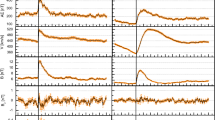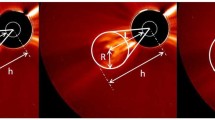Abstract
The structure and physical conditions in 104 coronal mass ejections (CMEs) with a clear-cut leading shock front have been considered using satellite data for 1996–2008. In 99% of cases, the action of increased shock front dynamic pressure on the Earth’s magnetosphere resulted in the origination of geomagnetic storms with sudden commencement.
It has been revealed that decreased magnetic field strength values correspond to denser plasma bunches in an ejection body and vice versa. As a result, gas pressure is decreased in regions with increased magnetic pressure. Thus, a self-consistent interrelationship between plasma parameters, which supports total pressure at mutual changes in gas and magnetic pressures, is observed in the ejection structure.
Pronounced differences in variations in the physical parameters in different zones along the front in the Earth-Sun direction have not been detected for each ejection. The maximal distances between the compared ejection zones are 2 million kilometers. This indicates that the ejection structure is stable.
The values of the shock front velocity (V psf), temperature (T psf), and density (N psf), as well as the ejection geometrical extension (L ae), have been compared for the considered ejections.
Cases when ejections followed one another at intervals of 3–30 h have been studied. It has been established that a leading ejection is strongly decelerated during its motion, and the next ejection faster covers the distance to the Earth. The next ejections with larger values of the plasma physical parameters are more geoeffective as compared to the previous ejections.
Similar content being viewed by others
References
Gonzalez, W.D., Tsurutani, B.T., and Gonzalez, A.L., Interplanetary Origin of Geomagnetic Storms, Space Sci. Rev., 1999, vol. 88, no. 3/4, pp. 529–562.
Khabarova, O.V. and Rudenchik, E.A., On the Possibility of Predicting Magnetic Storms Based on Monitoring the Solar Wind Oscillatory Mode, Preprint of Institute of Terrestrial Magnetism, Ionosphere, and Radiowave Propagation, Russ. Acad. Sci., Troitsk, 2003, no. 1(1154), p. 20.
Plunkett, S.P. and Thompson, B.J., Solar Source Regions of Coronal Mass Ejections and Their Geomagnetic Effects, J. Atmos. Sol.-Terr. Phys., 2001, vol. 63, no. 5, pp. 389–402.
Srivastava, N. and Venkatakrishnan, P., Relationship between CME Speed and Geomagnetic Storm Intensity, Geophys. Res. Lett., 2002, vol. 29, no. 9, pp. 1–11.
Author information
Authors and Affiliations
Additional information
Original Russian Text © G.S. Minasyants, T.M. Minasyants, 2011, published in Solnechno-Zemnaya Fizika, 2011, Vol. 17, pp. 49–53.
Rights and permissions
About this article
Cite this article
Minasyants, G.S., Minasyants, T.M. Structural and dynamic features of geoeffective coronal ejections. Geomagn. Aeron. 51, 1058–1062 (2011). https://doi.org/10.1134/S0016793211080238
Received:
Published:
Issue Date:
DOI: https://doi.org/10.1134/S0016793211080238




